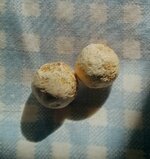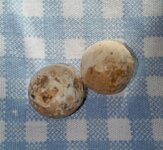Found these in the mtns near West Point . Obviously , there were troop movements all around here during the Revolution . Im very interested in dating them (close as possible) . If theyre just random things from a Victorian hunter , i'll def care less . If theyre the real deal /very historic , i'll like them a lot more . I did not measure but they look about 1/2" diam . Love to hear what other diggers think !!
You are using an out of date browser. It may not display this or other websites correctly.
You should upgrade or use an alternative browser.
You should upgrade or use an alternative browser.
18th century shot ?
- Thread starter MissLee
- Start date
Part II maybe these pics are better (?)Found these in the mtns near West Point . Obviously , there were troop movements all around here during the Revolution . Im very interested in dating them (close as possible) . If theyre just random things from a Victorian hunter , i'll def care less . If theyre the real deal /very historic , i'll like them a lot more . I did not measure but they look about 1/2" diam . Love to hear what other diggers think !!
Attachments
Cherry Picker
Forum Supporter
Size? I know here in Kansas, musket balls generally mean pre-1860s.
hoser
Forum Supporter
Those are very cool. Ok it's time for the stupid Hoser to show up. I don't have a black powder gun, I have shot a few that my friends have and they were round ball shot too. I also know that today round ball shot is used for deer hunting with BP. What are the determining factors that tell you the round ball bullets are from the revolution and not from semi modern day. Is it the amount of white corrosion on the ball. Please excuse my ignorance on this, but I am just curious.
Part II maybe these pics are better (?)Found these in the mtns near West Point . Obviously , there were troop movements all around here during the Revolution . Im very interested in dating them (close as possible) . If theyre just random things from a Victorian hunter , i'll def care less . If theyre the real deal /very historic , i'll like them a lot more . I did not measure but they look about 1/2" diam . Love to hear what other diggers think !!
Oh yes !! Tons of white concretion . They are lead , hand forned , the right size and shape . Everything is correct ; and im 100% they are antique ; just HOW old , is the question ? It also seems possible that some of the indentations are from a tooth/teeth . And , very oddly , if i can get you a better pic , one of the balls has marks exactly consistent with fingerprints . How or why , i couldnt say . Further , there is a very old cabin site on this mtn side which i know does date from the Rev. Unless soneone denies it convincingly , im tending to believe thats what these areThose are very cool. Ok it's time for the stupid Hoser to show up. I don't have a black powder gun, I have shot a few that my friends have and they were round ball shot too. I also know that today round ball shot is used for deer hunting with BP. What are the determining factors that tell you the round ball bullets are from the revolution and not from semi modern day. Is it the amount of white corrosion on the ball. Please excuse my ignorance on this, but I am just curious.
Let me get out the measur tape . Also let me try and get clearer pics . Dont know why these are so murky ; cheesy phone i guess (?)Size? I know here in Kansas, musket balls generally mean pre-1860s.
Def have to say 1/2 " . Its not the most precise measuremt , wobbling on the counter , but thats how it looks . More pics here which are likely overkill but someone might see something i dont .Let me get out the measur tape . Also let me try and get clearer pics . Dont know why these are so murky ; cheesy phone i guess (?)
Attachments
-
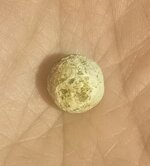 20240417_024005.jpg64.1 KB · Views: 18
20240417_024005.jpg64.1 KB · Views: 18 -
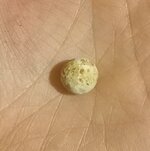 20240417_024207.jpg147 KB · Views: 17
20240417_024207.jpg147 KB · Views: 17 -
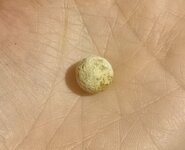 20240417_024501.jpg176.8 KB · Views: 15
20240417_024501.jpg176.8 KB · Views: 15 -
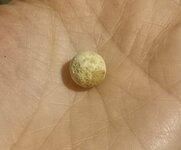 20240417_024442.jpg179.2 KB · Views: 18
20240417_024442.jpg179.2 KB · Views: 18 -
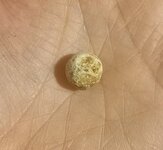 20240417_024525.jpg183.4 KB · Views: 17
20240417_024525.jpg183.4 KB · Views: 17 -
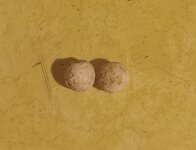 20240417_024540.jpg149 KB · Views: 17
20240417_024540.jpg149 KB · Views: 17 -
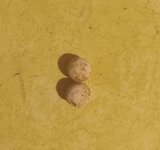 20240417_024551.jpg102.3 KB · Views: 18
20240417_024551.jpg102.3 KB · Views: 18 -
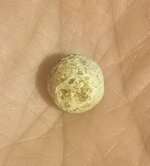 20240417_024005.jpg64.1 KB · Views: 21
20240417_024005.jpg64.1 KB · Views: 21 -
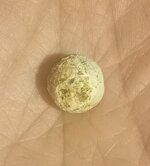 20240417_024005.jpg64.1 KB · Views: 20
20240417_024005.jpg64.1 KB · Views: 20
Would have deleted last two but i cant figure out devices for **** . Oh well .Def have to say 1/2 " . Its not the most precise measuremt , wobbling on the counter , but thats how it looks . More pics here which are likely overkill but someone might see something i dont .
stetam
Elite Member
1700's-1900's. Muzzle loading rifles were used a long long time and still are.
Steve
Steve
Ok . But this is still very old shot . At a certain point , (19th century?) shot would look more modern/factory made , no ?1700's-1900's. Muzzle loading rifles were used a long long time and still are.
Steve
Cherry Picker
Forum Supporter
To me, it has the patina of an old ball, not a modern one.Ok . But this is still very old shot . At a certain point , (19th century?) shot would look more modern/factory made , no ?
Patina is correct for older ball ammo, but unless they showed some sign of a sprew from a custom made shot with a die, then we cannot tell more. Place them on a millimeter scale and take a picture from directly above. Right now we have no idea of caliber. Guessing a half inch is just not precise enough for a reasonable caliber guess. Guns in use in the USA during the Revolutionary War were not standardized and many calibers were used! A gram weight for each one might be handy too! Best of luck!
Rock Jock
Elite Member
The French Charleville Musket was .69 caliber and the British Brown Bess Musket was .75 caliber. These were the primary military long arms in non-Spanish North America during most of the 18th and early 19th Century part of Colonial Era. Other calibers were popular for Kentucky/Pennsylvania Rifles, but your specimens don't seem bear any evidence of rifling grooves or significant impact deformation. One seems to have a dent of some sort. One wonders if these could have been an ammo spill. These were likely to be the primary arms of the militia members and civilian hunters/settlers. Calibers of these ranged from .25 cal. to .62 cal., with .40 to .48 cal. being most common. All of these above guns are flintlock firearms. If your specimens are truly .50 caliber then they would most likely fall into the latter class of civilian/militia arms. All of this is for naught if these were specimens of pistol ammo, which could also fall into these calibers. Some flintlock pistols were smoothbore and some were rifled, such as dueling arms.
Oh yeah ! I SO agree . Wish i could even ballpark a date but it may not be possible . Oh well . Its ye olde , i know that !!To me, it has the patina of an old ball, not a modern one.
Oh goodness . Im overwhelmed with the many diff considerations ! Seems like i cannot know much in the way of facts on them .The French Charleville Musket was .69 caliber and the British Brown Bess Musket was .75 caliber. These were the primary military long arms in non-Spanish North America during most of the 18th and early 19th Century part of Colonial Era. Other calibers were popular for Kentucky/Pennsylvania Rifles, but your specimens don't seem bear any evidence of rifling grooves or significant impact deformation. One seems to have a dent of some sort. One wonders if these could have been an ammo spill. These were likely to be the primary arms of the militia members and civilian hunters/settlers. Calibers of these ranged from .25 cal. to .62 cal., with .40 to .48 cal. being most common. All of these above guns are flintlock firearms. If your specimens are truly .50 caliber then they would most likely fall into the latter class of civilian/militia arms. All of this is for naught if these were specimens of pistol ammo, which could also fall into these calibers. Some flintlock pistols were smoothbore and some were rifled, such as dueling arms.
You guys are better at this than i am . I just end up confused and defeated and put them away again .Patina is correct for older ball ammo, but unless they showed some sign of a sprew from a custom made shot with a die, then we cannot tell more. Place them on a millimeter scale and take a picture from directly above. Right now we have no idea of caliber. Guessing a half inch is just not precise enough for a reasonable caliber guess. Guns in use in the USA during the Revolutionary War were not standardized and many calibers were used! A gram weight for each one might be handy too! Best of luck!


